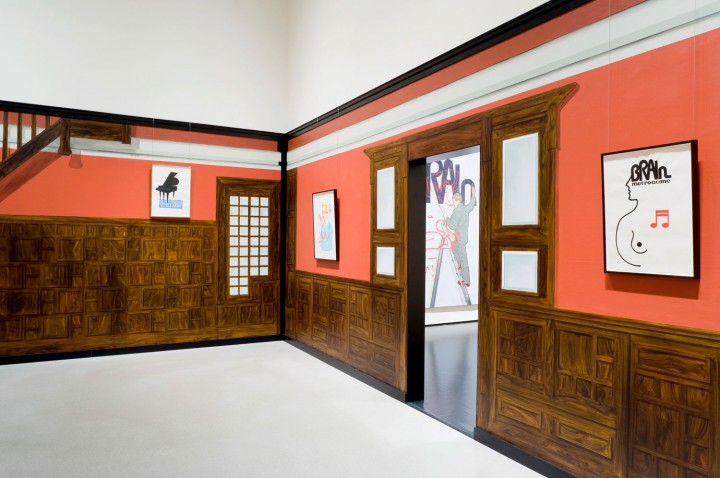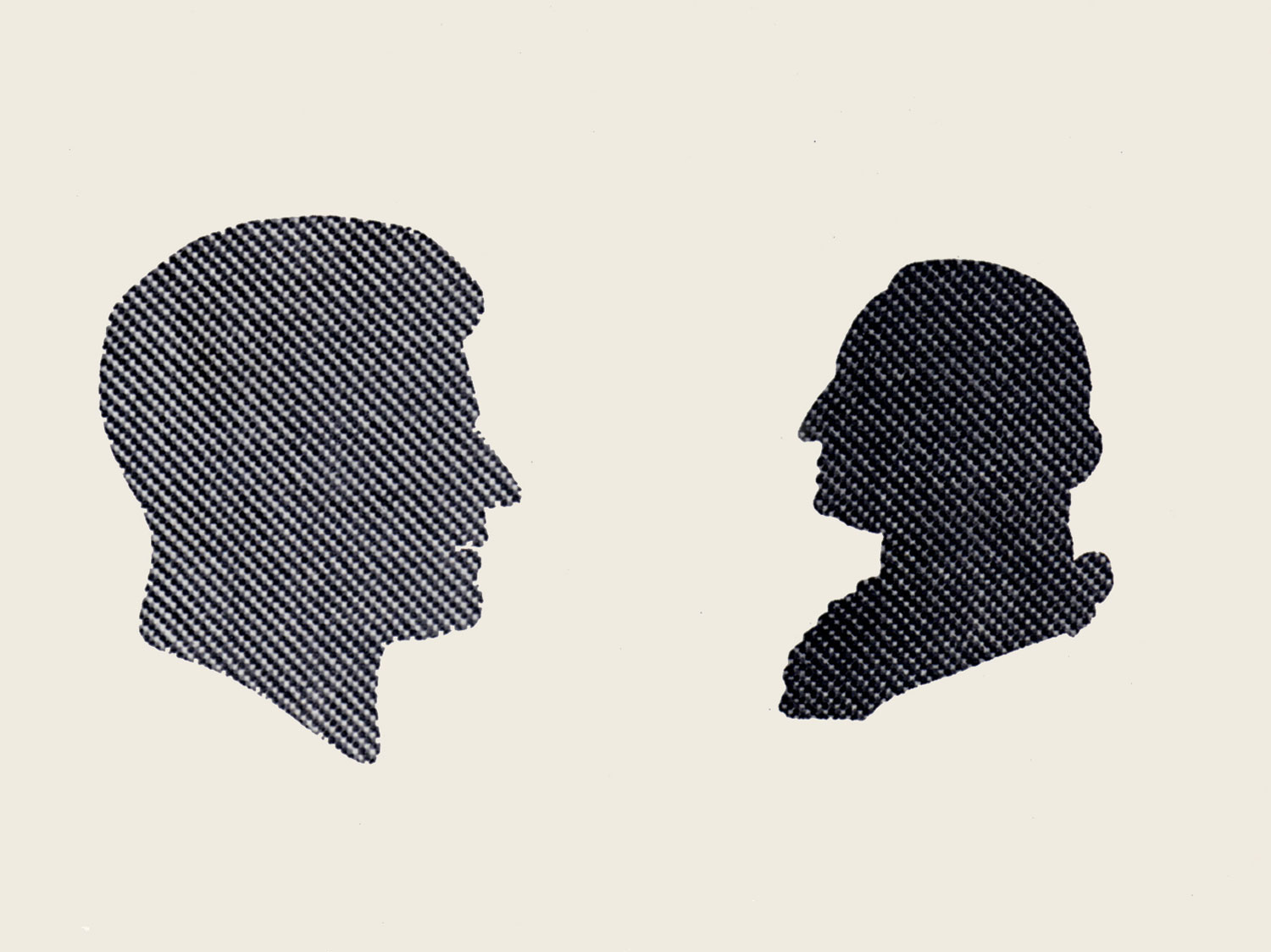The room was found empty, without a stick of furniture. The pictures on the walls had been taken down, leaving obvious traces on the trompe l’oeil of a cloudy sky roiling calmly above a paneling of pale wood. The paintings were small and must have been hanging there for a long time. A single survivor in an adjoining room: the portrait of the face of a woman and a man that seems to split into two in a simple and willful rotation of the head. He is looking to the right, while the woman turns her face to the left, keeping her gaze fixed in his direction. There is a vanishing point on which they both converge. The woman’s profile is recognizable: Lucile Desamory. And I suppose that the other, given the similarity of the features, is a close relative, perhaps her brother. It was Lucile who filmed the subject of my investigation in this place on her last public appearance. She was seated on a wooden bench, which has now disappeared along with the rest of the furniture; composed and motionless in a long dress of deep scarlet velvet, with her hair gathered in two plaits that undulatedto the right and left of her face, winding around the ears to join up again in a bun on the back of her neck. Enigmatic, a few words at the right moment. Obvious marks of damp spread over and weigh on the room, unpleasant infiltrations, heedless metallic stains that ooze from the ceiling. More menacing clouds of rust that put one in mind of an ill omen. The orthogonality of the room has been cracked open along one edge to create a passage. In this adjacent space three further finds have been made that can be helpful in defining the profile of the person in question and the nature of the events in which she has played a leading part.
Annotation: the footage has a title by which it can be identified, Abracadabra. And Lucile’s presence is not extemporaneous.

First Exhibit: Quodlibet (Steven Purvis)
Five different pairs of scissors hang from metal hooks on the upper edge of a corkboard onto which is pinned a methodically chaotic set of materials of various origins. Each set is always based on the interplay of constants and variables. What are the constants and what is variable in this over-inclusion? And above all what is the extraneous element, supposing that there is one? The setting is certainly one of tailoring or dressmaking. The scissors, arranged at fairly regular intervals, are turned by common consent to the right, configuring a rhythmically ordered succession. Most of the other “scraps” gravitate toward the bottom: faded notes, addresses of restaurants, reservations, receipts. A collection of buttons, a few pieces of thread and fabric. A lot of addresses: many of them inside small transparent plastic bags fixed to the lower left-hand side, while others serve as backdrops for the little “treasures” “impaled” on the board. There is a sort of tide that makes them wave on the seabed, with a few irreverent attempts to resurface. Along the upper edge sail the rings of the five pairs of scissors. A bag of light blue cloth with a yellow heart, which might hold a secret, is stapled almost at the center of the composition. There is an unusual verticalization of the written messages: they are hung sideways, making it hard to read them, requiring the curious to twist their heads ninety degrees. Nothing seems to be accidental. Everything is arranged with attention and care, apart perhaps from the little green plastic fork stuck on the bottom edge at the right and a pair of tweezers for eyebrows. This hortus siccus may refer to a particular period in her work and area of interest. We know in fact that in 2006 the subject “sublet” a space to Beca Lipscombe, a fashion designer from Edinburgh with whom she later set up the label Atelier E.B., in collaboration with the illustrator Bernie Reid (who used to be married to Beca). Recently they have announced the traveling presentation (Amsterdam/London/Brussels/Edinburgh) of a new collection, “Ost End Girls.”
Second Exhibit: Nova Popularna
A bench, a table and some chairs that suggest a hypothesis of conviviality in a bar decorated with a variety of figures. The dark wood of the tabletop, carved in an ornamental pattern along the perimeter, and the upper part of the seats have been “vandalized” by various probably indelible incisions and inscriptions that permit a contextualization and reading of supplementary clues. The memento mori coexist with the shadows of religious symbols: from the skull to the cross. From contextualization and reading of supplementary clues. The memento mori coexist with the shadows of religious symbols: from the skull to the cross. From the sacred to the profane with a row of stylized phalluses viewed in profile or from above. The word “DonAtella” may be a reference to Donatella Versace and to the joint project of Ed Laliq, Mark Leckey and Bonnie Camplin (this was in the early years of the 21st century). Other words and a few phrases can be made out: “Urmel,” “Tongue,” “Tegs,” “Young Team Fae Possil,” “The N.W.R.A.C.” And I can also recognize the reassuring invitation “MAN NO CRY.” A small heart, a series of origami and a multitude of doodles and crossings out. All pieces of evidence and traces that link the protagonist to a specific moment and another figure: Paulina Olowska, with whom she is attested to have run the Nova Popularna bar, located at no. 5 Ulica Chmielna in Warsaw, from May 2 to 29, 2003. The two saw a great deal of each other for several years and then lost touch (they are said to have been sighted together on the subway in Moscow, in the year 2005). The ornamental repertoire found was certainly employed in the bar in question and in all likelihood is linked to Copelia, the Polish Social Union of People’s Crafts and Arts. The graffiti that deface the pieces of furniture have a fortuitous and random nature: attempts perhaps by many or just a few to empty their heads or to leave a trace, in any case persuasive comments on the liberal management of the place of entertainment by the two governesses. I will add only that the aforementioned (and recurrent) Beca Lipscombe designed and made the outfits worn by both of them, taking her inspiration from Manet’s celebrated picture of A Bar at the Folies-Bergère, and that the idea was floated of limiting entrance solely to women on Wednesdays.

Third and Last Exhibit: Quodlibet (Self-Portrait)
The final find is the printout of an email in which some names and other words have been deleted. The exchange took place on February 5, 2010, between someone who signs himself “rk” (in all probability the photographer Richard Kern, mentioned below in the text of the email) and who forwards to the person in question an e-mail written by her the day before and addressed to two people whose profession is that of curator. I’m not going to dwell on the significance of the text; I invite you to read it for yourself. However, it refers to events that occurred a decade earlier, as well as to a more recent, grotesque and vulgar attempt at misappropriation or at least questionable use and to another collaboration, the one with Kern himself and indirectly with Cosey (probably the artist and musician Fanni Tutti), and presents an obdurate and lucid defense of her rights. The fact that she describes this file as a self-portrait is a further comment on her temperament and the firm and resolute decision to represent herself not with an image, but through her objection to the exploitation of her image as a woman.
Conclusions
Any conclusion is problematically and dramatically provisional. There is always something going on behind the scenes. The subject tends to elude any classification and definition. She moves between different styles, exploring many different fields and languages of representation. She is not interested in transcendence, but in a direct and visceral relationship with the context in which she is acting, with its material, social, historical and even commercial significance.





